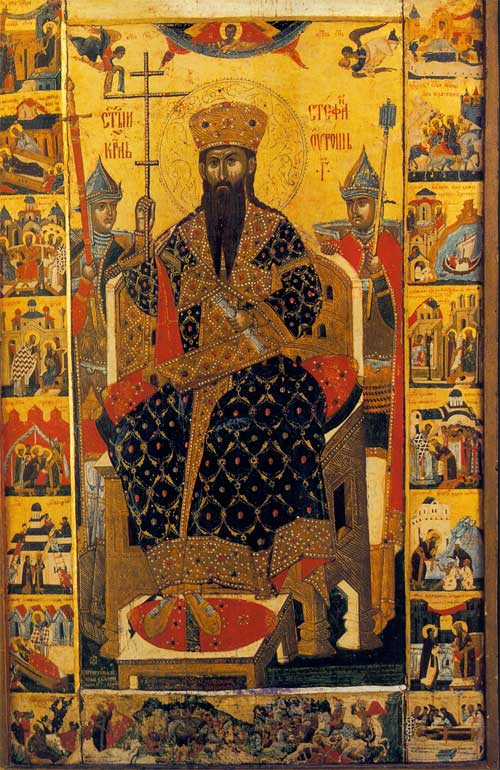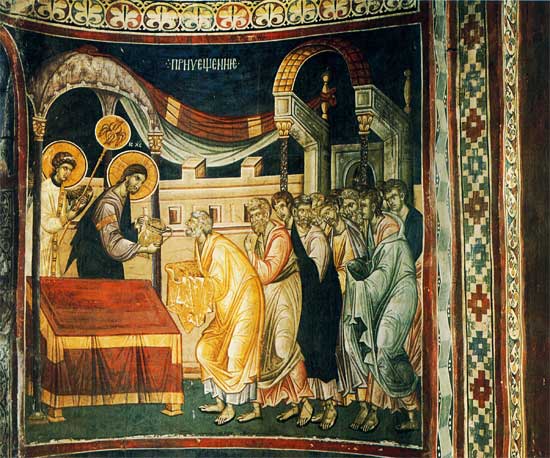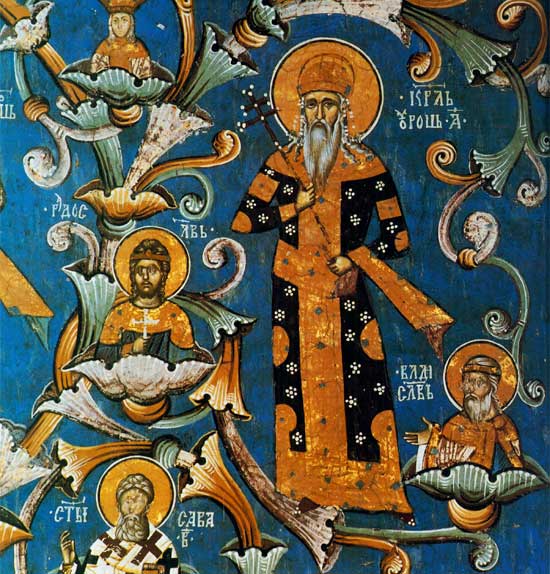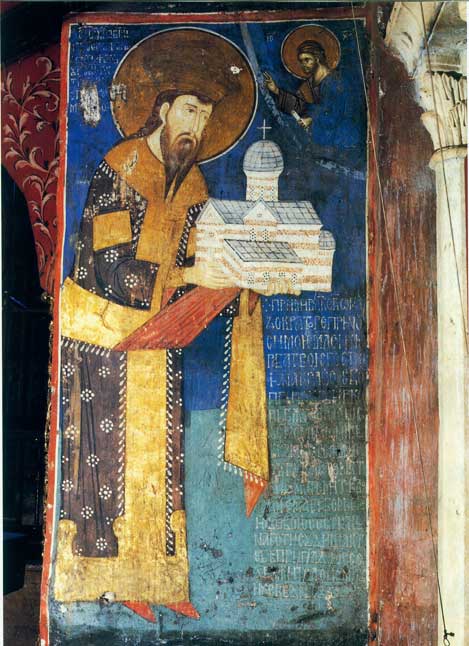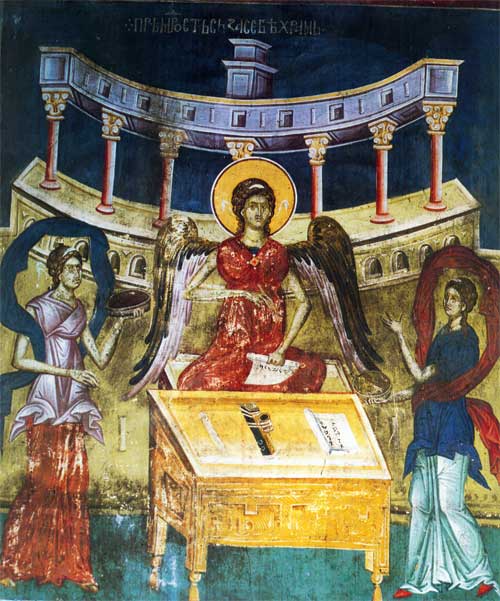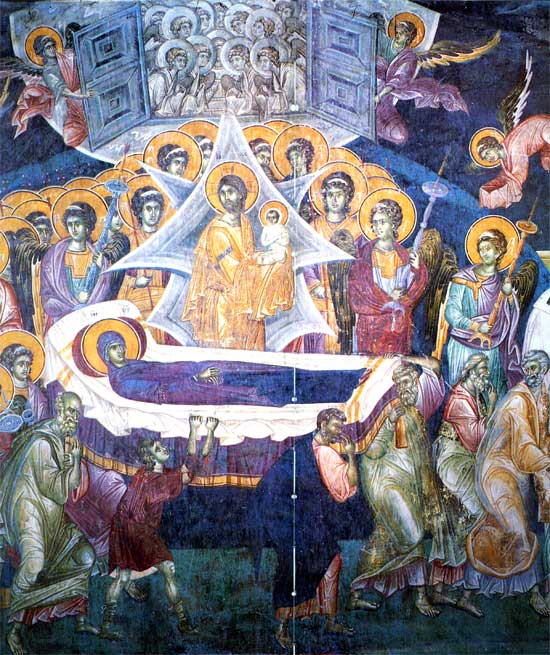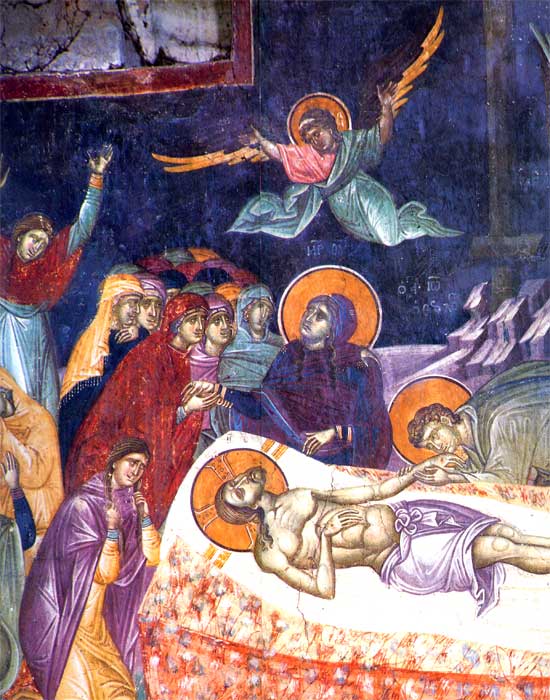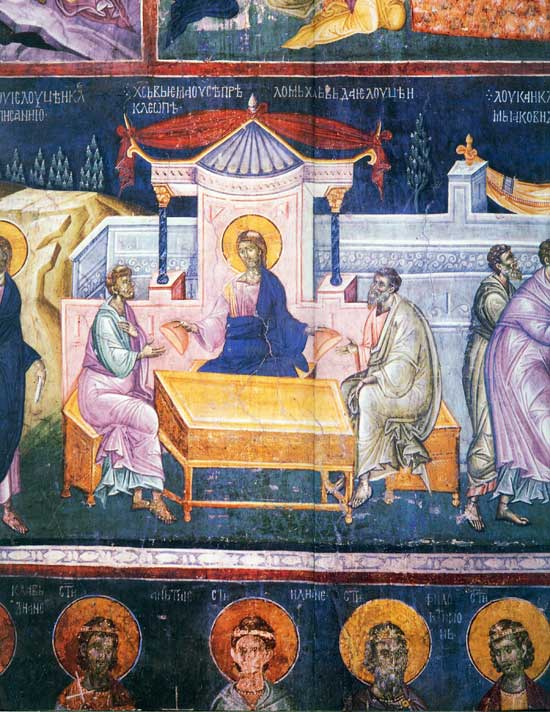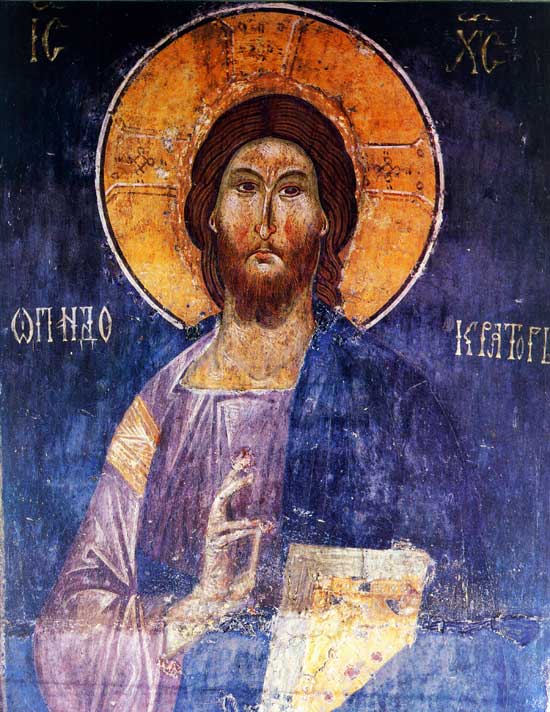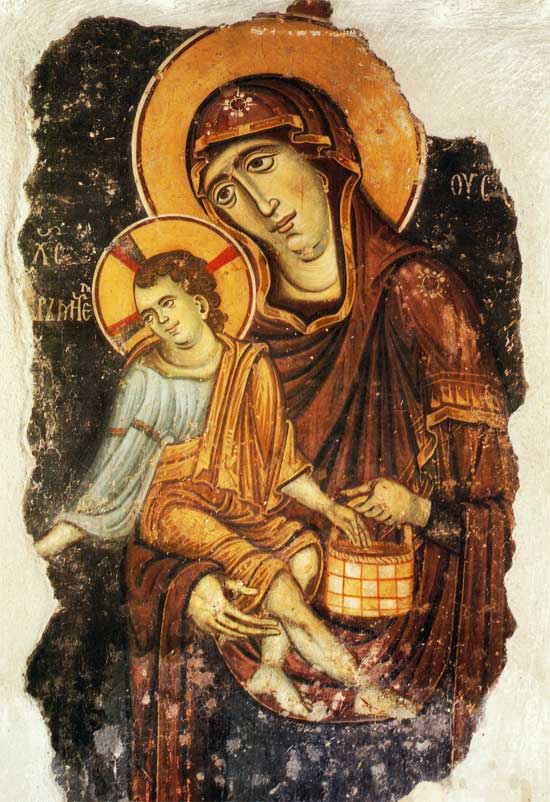
Welcome to the Tesla Memorial Society of New York Website
Hagia Sophia
(Ayasofya Museum, in Istanbul, Turkey) -
Hagia Sophia, the most beautiful Christian Church in the World from Byzantine Times. Today Hagia Sophia is a museum, honoring both the Christian and Muslim religions.
The Hagia Sophia was constructed in five years, from 532 to 537, at the orders of Emperor Justinian I and designed by Isidore of Miletus.
Immediately after the Turks conquered Constantinople (Istanbul) in 1453, the Hagia Sophia was converted to a mosque. In 1935, the first Turkish President and founder of the Republic of Turkey, Mustafa Kemal Atatürk, transformed the building into a museum. The carpets were removed and the marble floor decorations appeared for the first time in centuries, while the white plaster which covered the mosaics were peeled off with the long and careful work of experts.
Dr. Ljubo Vujovic, President, Tesla Memorial Society of New York, wrote a book entitled "Roman Empire", the following passages and photographs are from this book.
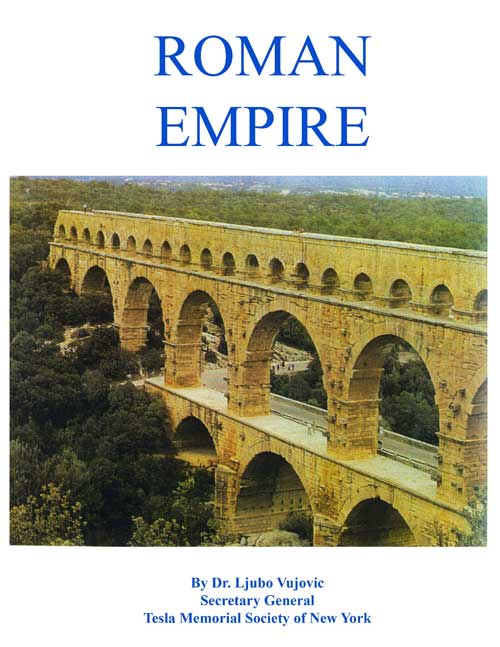
Hagia Sophia - Istanbul, Turkey
"It is a beautiful and important monument and an international, inter-cultural treasure. The Christian mosaics should be restored as well as possible, but the great black and gold calligraphic disks, the mihrab and the speaker's podium are also beautiful treasures and should remain. Unless and until it can be shared by both religions in harmony - which would be a grand idea - it should remain a secular building honoring both religions who have made it beautiful.
The Turks could have stripped the mosaics off and re-used them; they chose to leave them in place for future generations."
Elena Dent, Member, Tesla Memorial Society of New York
CHRIST PANTOKRATOR, Mid-12th century, mosaic Cefalu, Basilica
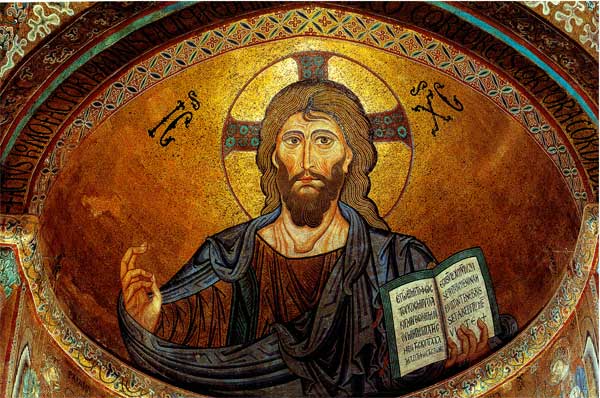
Above: CHRIST PANTOKRATOR, Mid-12th century, mosaic Cefalu, Basilica.
From Wikipedia – the free encyclopedia:
The Pantokrator, largely a Byzantine or Eastern Orthodox theological issue is by that name largely unknown to Roman Catholicism and most Protestants. Pantokrator is roughly synonymous with the western concept of omnipotence. But omnipotence is power in stasis while the power of the Pantokrator is dynamic.
The Birth of Christianity
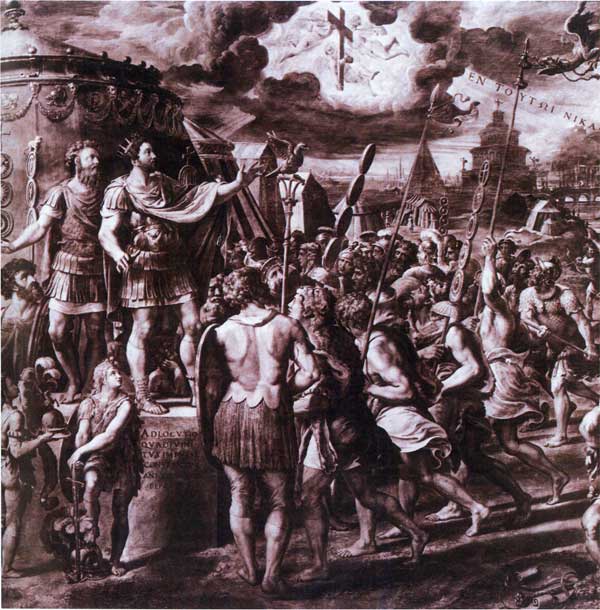
Above: The Vision of Constantine - The Birth of Christianity.
Constantine the Great, Roman Emperor, introduced Christianity into the Roman Empire. October 28th, AD 312.
The Vision of Constantine of the Cross which was reputed to have seen a flash across the sky prior to his victorious battle against Maxentius at Milvian Bridge outside Rome October 28th, AD 312.
The Emperor Constantine moved to the new capital of the Eastern Roman Empire Constantinople in 330 A.D. He is the founder of the Eastern Roman Empire, which was renamed as the Byzantine Empire. It influenced a lot of the transformation of the linguistic heritage of Ancient Greece into the new Christian civilization.
In 1453 the Byzantine Empire was occupied by the Turks, and remained under its administration for more than 400 years. During this period their language and religion did not suffer any changes.
On March 25, 1821, the Greeks rose up against the Turks, winning their Independence by 1828. Greece struggled for its territory a long time and returned the major part of it, as: Epirus and Thessalia in 1881. Kriti and Makedonia were added in 1913. At the end of the World War II the Dodecanissos islands were also returned to Greece.
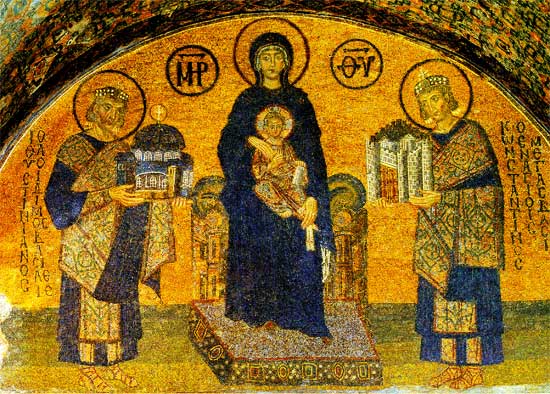
Above: Enthroned Virgin and Child Between Constantine and Justinian.
From Wikipedia – the free encyclopedia:
CONSTANTINE THE GREAT
Full name Flavius Valerius Aurelius Constantinus
Born 27 February c. 274. Naissus (modern Niš, Serbia), Died 22 May 337, Buried Constantinople. Predecessor Constantius Chlorus
Father Constantius Chlorus. Mother Helen.
Constantine is best known for being the first Christian Roman Emperor. In 313, Constantine announced toleration of Christianity in the Edict of Milan, which removed penalties for professing Christianity (under which many had been martyred in previous persecutions) and returned confiscated Church property. Scholars debate whether Constantine adopted his mother St. Helena's Christianity in his youth, or whether he adopted it gradually over the course of his life. Constantine is also remembered for convoking the Council of Nicaea in 325, one of many significant impacts the emperor had in the development of the Christian religion.
In 324, Constantine announced his decision to transform Byzantium into Nova Roma and on May 11, 330, he officially proclaimed the city as the new capital of the Roman Empire. The city was renamed Constantinople, The City of Constantine, after Constantine's death in 337. Constantinople was the first Christian city in the world, as no pagan temples or sites were permitted[citation needed]. It would remain the capital of the Byzantine Empire for over a thousand years, until Ottoman Turks captured the city in 1453 and eventually renamed it Istanbul (the name change was made official in 1930).
Hagia Sophia - Istanbul, Turkey
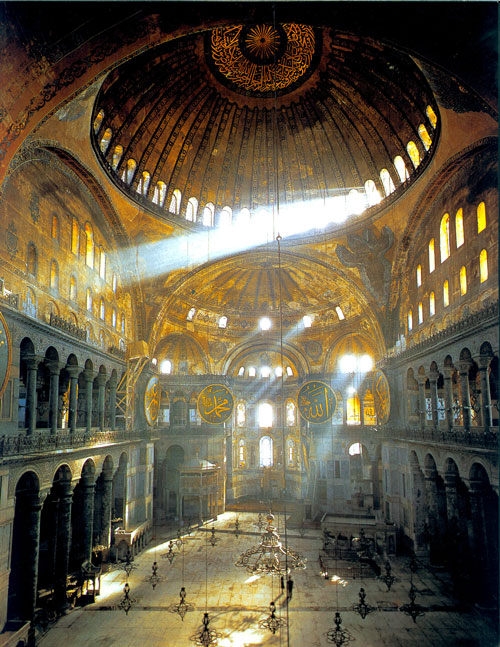
Above: BASILICA OF HAGIA SOFIA, Interior view facing east, Istanbul, Turkey
(Page 29 - "Roman Empire")
BASILICA OF HAGIA SOFIA
Interior view facing east
Istanbul, Turkey
From Wikipedia – the free encyclopedia
Hagia Sophia was the seat of the Orthodox patriarch of Constantinople and a principal setting for Byzantine imperial ceremonies.The structure has been severely damaged several times by earthquakes. The dome collapsed after an earthquake in 558 and was replaced in 562, while the reparation works were completed a year later, in 563, when the building was rededicated. There were additional partial collapses in 989 after which an Armenian architect named Trdat was commissioned to repair the damage. In the 16th century, during the reign of Selim II, the building started showing signs of fatigue and was extensively strengthened with the addition of structural supports to its exterior by the great Ottoman architect Sinan who is also considered one of the first earthquake engineers in the world.
During the Latin occupation of Constantinople (1204–1261) the church became a Roman Catholic cathedral. Enrico Dandolo, the Doge of Venice who commanded the sack and invasion of the city by the Latin Crusaders in 1204, during the Fourth Crusade, is buried inside the church. The tomb inscription carrying his name, which has become a part of the floor decoration, received numerous spits from the angry Byzantines who recaptured Constantinople in 1261.
Immediately after the Turks conquered Constantinople (Istanbul) in 1453, the Hagia Sophia was converted to a mosque. In 1935, the first Turkish President and founder of the Republic of Turkey, Mustafa Kemal Atatürk, transformed the building into a museum. The carpets were removed and the marble floor decorations appeared for the first time in centuries, while the white plaster which covered the mosaics were peeled off with the long and careful work of experts.
The building was restored and repaired numerous times by Ottoman architects. The most famous and extensive work was done by Mimar Sinan, one of the most famous architects in history, in the 16th century, which included the addition of structural supports to the exterior of the building, the replacement of the old minarets with the minarets that stand today, and the addition of Islamic pulpits and art
For almost 500 years the principal mosque of Istanbul, Ayasofya served as a model for many of the Ottoman mosques such as the Şehzade Mosque, the Süleymaniye Mosque, and the Rüstem Pasha Mosque.
Hagia Sophia - Images from www.greatistanbul.com
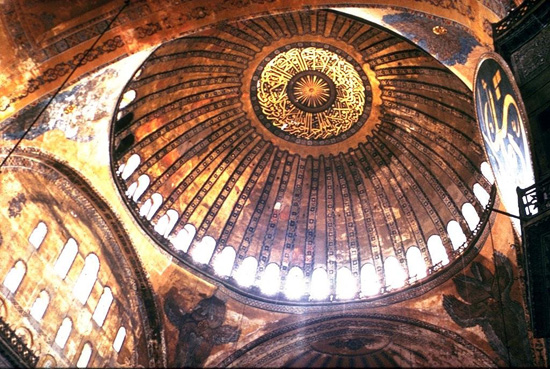
Above: Hagia Sophia. Image from www.greatistanbul.com
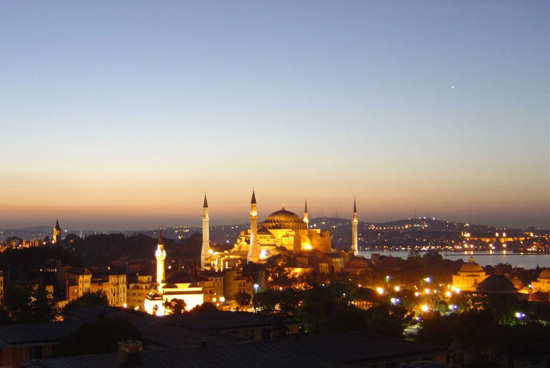
Above: Hagia Sophia. Image from www.greatistanbul.com
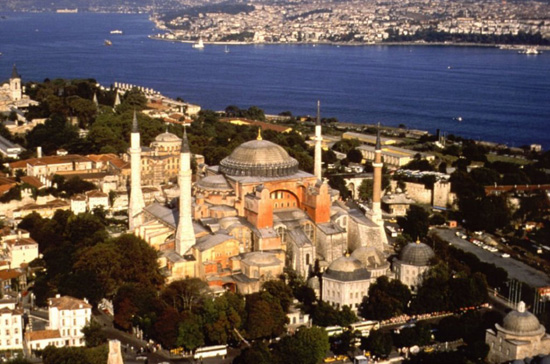
Above: Hagia Sophia. Image from www.greatistanbul.com
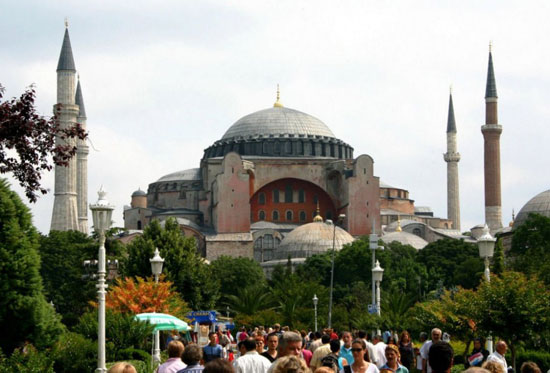
Above: Hagia Sophia. Image from www.greatistanbul.com
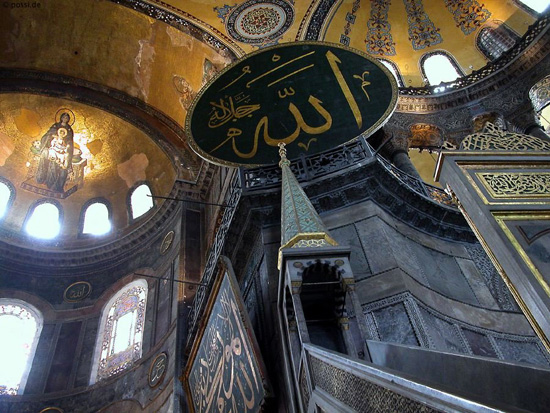
Above: Hagia Sophia. Image from www.greatistanbul.com
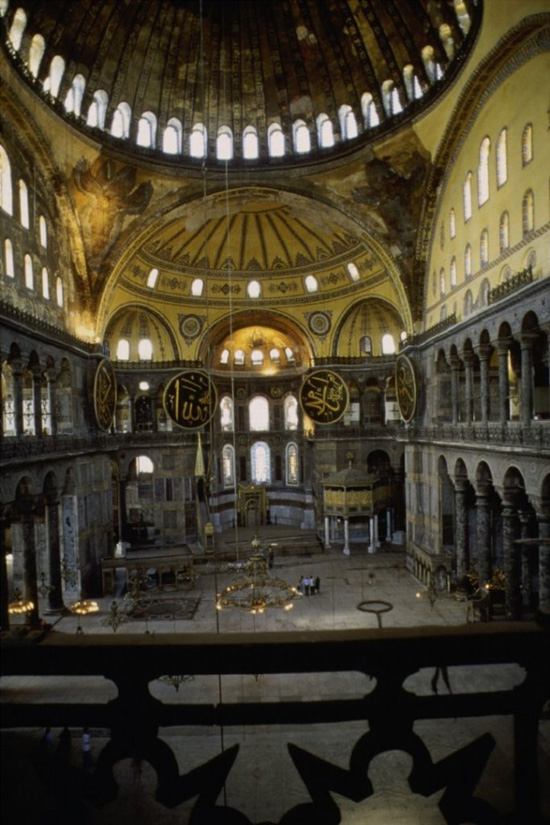
Above: Hagia Sophia. Image from www.greatistanbul.com
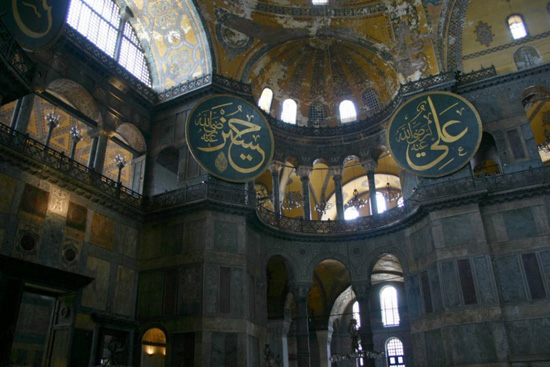
Above: Hagia Sophia. Image from www.greatistanbul.com
Hagia Sophia - Istanbul, Turkey
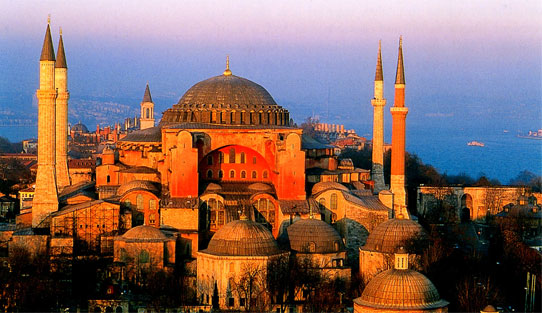
Above: BASILICA OF HAGIA SOPHIA, view from the south, Istanbul, Turkey
BASILICA OF HAGIA SOPHIA
View from the south
Istanbul, Turkey
Hagia Sophia now known as the Ayasofya Museum, was the greatest Christian cathedral of the Middle Ages, later converted into an imperial mosque in 1453 by the Ottoman Empire, and into a museum in 1935. It is located in Istanbul, Turkey. It is considered one of the greatest and most beautiful buildings in history. Its conquest by the Ottomans at the fall of Constantinople is considered one of the great tragedies of Christianity by the Greek Orthodox faithful.
It was constructed in five years, from 532 to 537, at the orders of Emperor Justinian I and designed by Isidore of Miletus.
The church of Hagia Sophia in Constantinople, was the center of Eastern Orthodox Christianity for many centuries.
Hagia Sophia - Istanbul, Turkey
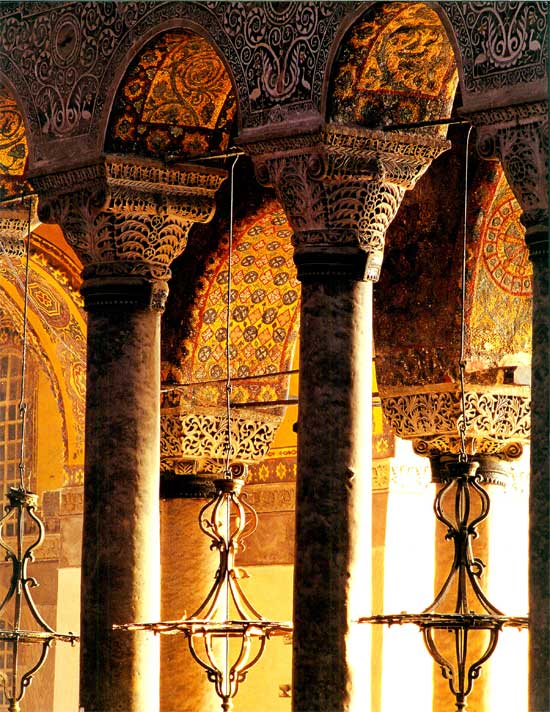
Above: One thousand-year artistic heritage of the great Christian Empire of the East – Byzantine Empire. Interior of the Church of Hagia Sophia.
One thousand-year artistic heritage of the great Christian Empire of the East – Byzantine Empire
Byzantine Art
Byzantine Art is the torch-bearer of early Christianity and the symbol of the Eastern Empire. Byzantine Art was under the influences of classical and oriental cultures. From the foundation of Constantinople on the site of ancient Greek town of Byzantium by Constantine the Great in 330 to the fall of the city to the Turks in 1453, the Byzantine Art was the reflection of the glory of the Great Christian Empire.
The leading artistic centres of the Byzantine Art are Constantinople with its symbol, Hagia Sophia, San Marko in Venice with its treasures, the monasteries of St Catherine in Sinai, the Mount Athos in Greece and the monasteries of Macedonia, Serbia, Bulgaria and Russia.
Hagia Sophia - Istanbul, Turkey
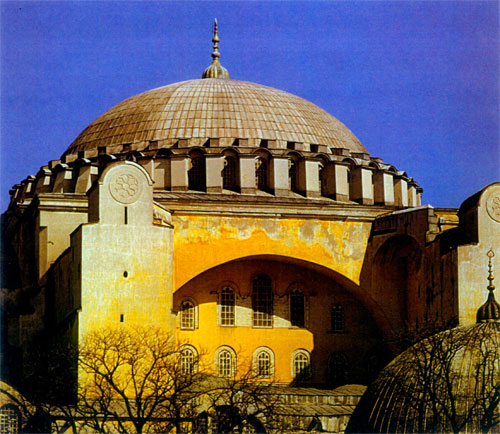
Above: The Great Dome of the Church of Santa Sophia.
The following below was taken from the Hagia Sophia Website:
If you believe in the just case that Hagia Sophia should be restored to its proper religious role as a church, for which it was built in the first place, then please support this petition to the EU Parliament that Turkey should not be admitted as a member of the European Union until it restores Hagia Sophia to its original purpose as a church and not a museum.
A minimum of 1.000.000 signatures are needed in order to persuade the European Union to consider this proposal seriously.
As you know, Turkey is doing everything it can today to convince the European Union that it is a worthy country to join it. If you believe that Turkey should not be admitted to the EU before restoring justice to Hagia Sophia, please click on "Your Signature" and send your message.
I would be grateful if you could also tell your friends about this site and its purpose.
Angeliki Papagika
Hagia Sophia
Hagia Sophia is not a public building that changed ownership with the conquest of a war. Hagia Sophia is a place of God, Christendom’s grandest place of worship for over 900 years, and arguably the most perfect and beautiful church that has been erected by any Christian people. The splendour of its overall effect, its “paradise-like” beauty and architectural brilliance were often comprehensible only in terms of repeated divine intervention.
The magnificence, spirituality and prestige of the Great Church led to its being appropriated as an imperial and religious symbol by the Ottoman sultans. The church of Christ was possessed and converted into a mosque, until it was decreed a museum. During this long time, it has been subjected to more than its fair share of abuse and denigration.
Hagia Sophia, an essential element of Christianity, a second Jerusalem, the most revolutionary and daring church conceived in Christendom, has been turned into a museum considerably impaired by the loss of all its Christian furnishings and much of its original setting and atmosphere. At present it is part of an increasingly elaborate area of monuments, museums, and rug and souvenir shops. The Great Church, transformed into a monument/museum without life…The conquest of war does not and cannot change its spiritual nature into a civil-cultural-secular institution. For as long as the injustice done to the soul of Hagia Sophia is ignored and forgotten Christianity cannot be whole. Hagia Sophia’s reason for existing is vitally important to restoring religious integrity.
It is a disgrace and disrespect to a religion and God when holy places are unwillingly turned purely into tourist attractions. How would the Muslims feel if one of their holiest places was turned into a museum for tourists by a conquering power?
With its conversion into a museum in 1934, Hagia Sophia was frozen in some past age, vaguely Byzantine. Directed by the then historicist paradigm that saw the past as unchanging, Hagia Sophia was also understood through the aesthetic of the great museum, that is, aloof and imposing. Both traits were useful to a Turkish government that wanted to break with the Ottoman era that lasted until after World War I. The church of Heavenly Wisdom became thus what the official Turkish act of secularisation called a “unique architectural monument of art” and hence was valued more for its age, art and historical value than for its practical and religious use.
Times have changed. Turkey has long severed its ties with the darker aspects of its Ottoman past. It aspires to join the European Union. The time has come to restore Hagia Sophia’s spirituality as a place of Christian worship. Turkey has to remember that old wisdom that says, “Do not do to others what you don’t wish them to do unto you”. Justice must prevail so that religious integrity might be restored. Turkey has to face up to its history and address this vital issue.
In 1847, a progressive sultan, Abdülmecid I(r. 1839-61), commissioned the Swiss architect Gaspare Fossati to restore the structure of Hagia Sophia, then Ayasofya Camii. When Fossati and his team began work on Hagia Sophia in 1847, after more than a century of neglect, they found the building in a dilapidated state with a leaking roof and “clouds of pigeons” despoiling the interior. They repaired cracks in the domes and vaults, and placed an iron chain around its base to contain its outward thrust. However they removed four flying buttresses that seemed to serve no purpose. They replaced the leaking lead covering of the roofs and carried out a complete cleaning inside and out. As the deteriorated plaster was chipped off walls and vaults, decorative Byzantine mosaics, shimmering with gold, were revealed. The sultan, astonished by their beauty, ordered Fossati and his team to uncover all the mosaics. When those in the galleries were uncovered and repaired, Fossati beseeched Abdülmecid to relax the rigid principles that demanded their obliteration. “They are beautiful,” Abdülmecid said. “Hide them because our religion forbids them. Hide them well, but do not destroy them: For who knows what might happen.”
Sultan Abdülmecid was intent on modernizing his kingdom and strengthening its ties with Western Europe at a moment when the great gulf between Turkey and Europe was beginning to narrow, a process that continues in our day. For him Hagia Sophia was part of a policy of progressive reform. Abdülmecid, whose reign had started with the proclamation of the Tanzimat, the most important milestone in the Westernisation of the Ottoman state and culture, encouraged uncovering the mosaics for repair and criticized his predecessors for having obscured these beautiful ornaments. He took advantage of the hajj (pilgrimage) to send the most fanatical imams of the (then) mosque to Mecca, before he undertook the restoration.
If Turkey aspires to join the community of Europe, the first step would be to show a spirit of understanding and a sense of justice, mutual respect and willingness to cooperate, as is the culture of the European Union. The time to restore the spirituality of Hagia Sophia as a place of Christian worship is now. The spiritual “redemption” of the Holy Wisdom church might be realized with the same care and respect with which Abdülmecid, that progressive, proeuropean reformer of the Ottoman Empire, commissioned the last major Ottoman restoration of Hagia Sophia.
History might neglect but it never forgets. Historic mistakes can be reversed and corrected. By taking the big and noble step of redeeming Hagia Sophia, the Turkish state would prove its genuine respect for the Christians of Europe and the world. Restoring Hagia Sophia to Christian worship would be THE revolutionary gesture of wisdom, progress and civility. Such an act would offer Istanbul the rare privilege of hosting not only a great monument of world art, but also one of Christianity’s most important places of worship, a truly rare diamond.
Angeliki Papagika
Frescos of Kosovo
The Sacred Land
from Gojko Subotic
